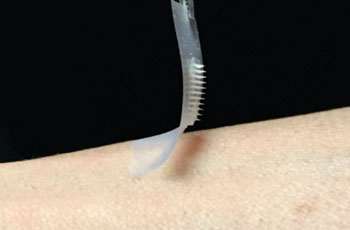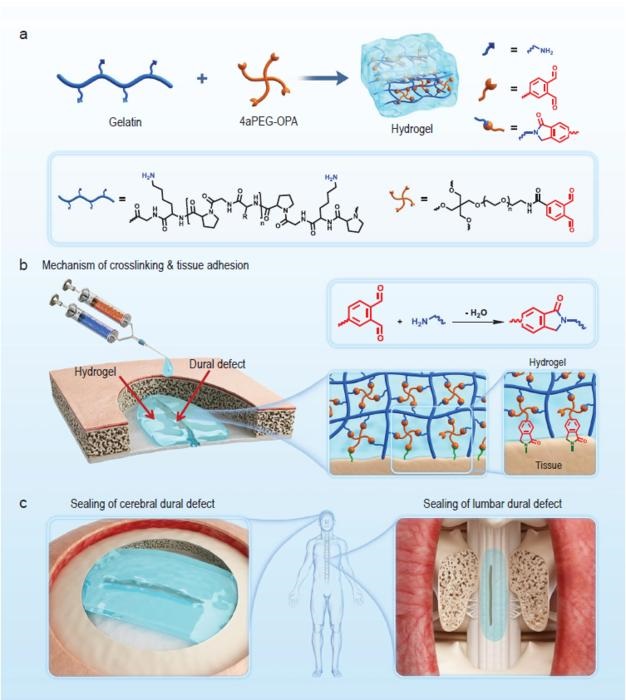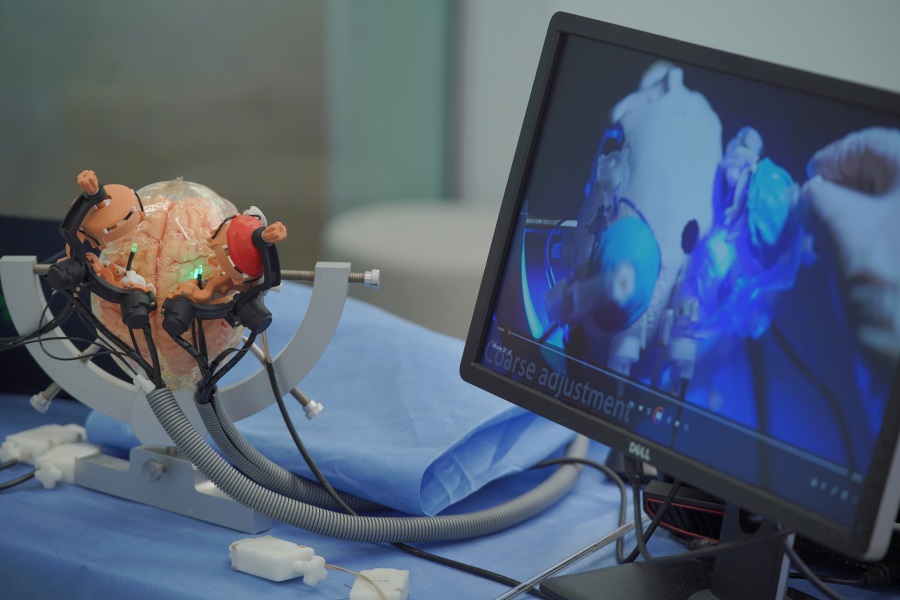Smart Insulin Patch Could Replace Painful Injections
|
By HospiMedica International staff writers Posted on 22 Jul 2015 |

Image: The hyaluronic acid microneedle-array insulin patch (Credit: Courtesy Zhen Gu, PhD/University of North Carolina).
A new study describes a novel skin patch that can detect blood sugar levels and secrete doses of insulin whenever needed.
Developed by researchers at North Carolina State University (NCSU; Raleigh, USA) and the University of North Carolina (UNC; Chapel Hill, USA), the insulin patch developed is in essence a glucose-responsive “closed-loop” insulin delivery system that mimics the function of pancreatic beta cells. The patch is based on a microneedle-array containing glucose-responsive vesicles (GRVs) which are loaded with insulin and glucose oxidase (GOx), an enzyme that causes hypoxia when it comes in contact with blood glucose.
The GRVs, who have an average diameter of 118 nm, are self-assembled from hypoxia-sensitive hyaluronic acid (HS-HA) conjugated with 2-nitroimidazole (NI), a hydrophobic component that undergoes bioreduction under hypoxic conditions. They are incorporated into microneedles made of rigid hyaluronic acid. When the local hypoxic microenvironment caused by the GOx enzymatic oxidation of glucose in the hyperglycemic state causes reduction of HS-HA, a rapid dissociation of the GRVs occurs, with subsequent release of insulin.
The researchers arranged more than one hundred of these microneedles on a thin silicon strip to create the patch. When the patch is placed onto the skin, the microneedles penetrate the surface, tapping into the blood flowing through the capillaries just below. The researchers then tested the patch in a mouse model of chemically induced type 1 diabetes. They found that the microneedle patch effectively regulated the blood glucose within thirty minutes, and stayed that way for several hours. The study was published in the July 7, 2015, issue of Proceedings of the National Academy of Sciences of the United States of America (PNAS).
“We have designed a patch for diabetes that works fast, is easy to use, and is made from nontoxic, biocompatible materials,” said co-senior author Prof. Zhen Gu, PhD, of the joint department of biomedical engineering at NCSU and UNC. “The whole system can be personalized to account for a diabetic’s weight and sensitivity to insulin, so we could make the smart patch even smarter.”
“The hard part of diabetes care is not the insulin shots, or the blood sugar checks, or the diet, but the fact that you have to do them all several times a day every day for the rest of your life,” added co-senior author John Buse, MD, PhD, director of the UNC Diabetes Care Center. “Injecting the wrong amount of medication can lead to significant complications like blindness and limb amputations, or even more disastrous consequences such as diabetic comas and death. If we can get these patches to work in people, it will be a game changer.”
Related Links:
North Carolina State University
University of North Carolina
Developed by researchers at North Carolina State University (NCSU; Raleigh, USA) and the University of North Carolina (UNC; Chapel Hill, USA), the insulin patch developed is in essence a glucose-responsive “closed-loop” insulin delivery system that mimics the function of pancreatic beta cells. The patch is based on a microneedle-array containing glucose-responsive vesicles (GRVs) which are loaded with insulin and glucose oxidase (GOx), an enzyme that causes hypoxia when it comes in contact with blood glucose.
The GRVs, who have an average diameter of 118 nm, are self-assembled from hypoxia-sensitive hyaluronic acid (HS-HA) conjugated with 2-nitroimidazole (NI), a hydrophobic component that undergoes bioreduction under hypoxic conditions. They are incorporated into microneedles made of rigid hyaluronic acid. When the local hypoxic microenvironment caused by the GOx enzymatic oxidation of glucose in the hyperglycemic state causes reduction of HS-HA, a rapid dissociation of the GRVs occurs, with subsequent release of insulin.
The researchers arranged more than one hundred of these microneedles on a thin silicon strip to create the patch. When the patch is placed onto the skin, the microneedles penetrate the surface, tapping into the blood flowing through the capillaries just below. The researchers then tested the patch in a mouse model of chemically induced type 1 diabetes. They found that the microneedle patch effectively regulated the blood glucose within thirty minutes, and stayed that way for several hours. The study was published in the July 7, 2015, issue of Proceedings of the National Academy of Sciences of the United States of America (PNAS).
“We have designed a patch for diabetes that works fast, is easy to use, and is made from nontoxic, biocompatible materials,” said co-senior author Prof. Zhen Gu, PhD, of the joint department of biomedical engineering at NCSU and UNC. “The whole system can be personalized to account for a diabetic’s weight and sensitivity to insulin, so we could make the smart patch even smarter.”
“The hard part of diabetes care is not the insulin shots, or the blood sugar checks, or the diet, but the fact that you have to do them all several times a day every day for the rest of your life,” added co-senior author John Buse, MD, PhD, director of the UNC Diabetes Care Center. “Injecting the wrong amount of medication can lead to significant complications like blindness and limb amputations, or even more disastrous consequences such as diabetic comas and death. If we can get these patches to work in people, it will be a game changer.”
Related Links:
North Carolina State University
University of North Carolina
Latest Critical Care News
- AI Doubles Medical Professionals’ Accuracy in Reading EEG Charts of ICU Patients
- Flexible Device Enables Sweat Gland Stimulation and Simultaneous Biosensing
- WHO Publishes First Global Guidelines to Reduce Bloodstream Infections from Catheter Use
- Innovative Material Paves Way for Next-Generation Wearable Devices
- Wireless Electronic Suture Enables Postoperative Long-Term Monitoring Of Soft Tissue
- Transcatheter Valve Replacement Outcomes Similar To Surgery, Finds Study
- Revascularization Improves Life Quality in Chronic Limb-Threatening Ischemia, Finds Study
- Powerful AI Risk Assessment Tool Predicts Outcomes in Heart Failure Patients
- Peptide-Based Hydrogels Repair Damaged Organs and Tissues On-The-Spot
- One-Hour Endoscopic Procedure Could Eliminate Need for Insulin for Type 2 Diabetes
- AI Can Prioritize Emergency Department Patients Requiring Urgent Treatment
- AI to Improve Diagnosis of Atrial Fibrillation
- Stretchable Microneedles to Help In Accurate Tracking of Abnormalities and Identifying Rapid Treatment
- Machine Learning Tool Identifies Rare, Undiagnosed Immune Disorders from Patient EHRs
- On-Skin Wearable Bioelectronic Device Paves Way for Intelligent Implants
- First-Of-Its-Kind Dissolvable Stent to Improve Outcomes for Patients with Severe PAD
Channels
Artificial Intelligence
view channel
AI-Powered Algorithm to Revolutionize Detection of Atrial Fibrillation
Atrial fibrillation (AFib), a condition characterized by an irregular and often rapid heart rate, is linked to increased risks of stroke and heart failure. This is because the irregular heartbeat in AFib... Read more
AI Diagnostic Tool Accurately Detects Valvular Disorders Often Missed by Doctors
Doctors generally use stethoscopes to listen for the characteristic lub-dub sounds made by heart valves opening and closing. They also listen for less prominent sounds that indicate problems with these valves.... Read moreSurgical Techniques
view channel
Study Warns Against Dangerous Smoke Levels Produced During Endoscopic Gastrointestinal Procedures
Healthcare professionals involved in certain smoke-generating endoscopic gastrointestinal procedures, such as those using electrical current to excise polyps, may be exposed to toxin levels comparable... Read more
New Hydrogel Sealant Effective at Sealing Dural Defects and Preventing Postoperative Adhesion
The dura mater is a fibrous membrane of connective tissue that envelops the brain and spinal cord. In neurosurgical procedures that require access to the brain or spinal cord, opening the dura mater often... Read more
MRI-Guided Multi-Stage Robotic Positioner Enhances Stereotactic Neurosurgery Precision
Magnetic resonance imaging (MRI) offers significant benefits in neurosurgery, providing detailed 3D visualizations of neurovascular structures and tumors. Traditionally, its use has been restricted to... Read morePatient Care
view channelFirst-Of-Its-Kind Portable Germicidal Light Technology Disinfects High-Touch Clinical Surfaces in Seconds
Reducing healthcare-acquired infections (HAIs) remains a pressing issue within global healthcare systems. In the United States alone, 1.7 million patients contract HAIs annually, leading to approximately... Read more
Surgical Capacity Optimization Solution Helps Hospitals Boost OR Utilization
An innovative solution has the capability to transform surgical capacity utilization by targeting the root cause of surgical block time inefficiencies. Fujitsu Limited’s (Tokyo, Japan) Surgical Capacity... Read more
Game-Changing Innovation in Surgical Instrument Sterilization Significantly Improves OR Throughput
A groundbreaking innovation enables hospitals to significantly improve instrument processing time and throughput in operating rooms (ORs) and sterile processing departments. Turbett Surgical, Inc.... Read moreHealth IT
view channel
Machine Learning Model Improves Mortality Risk Prediction for Cardiac Surgery Patients
Machine learning algorithms have been deployed to create predictive models in various medical fields, with some demonstrating improved outcomes compared to their standard-of-care counterparts.... Read more
Strategic Collaboration to Develop and Integrate Generative AI into Healthcare
Top industry experts have underscored the immediate requirement for healthcare systems and hospitals to respond to severe cost and margin pressures. Close to half of U.S. hospitals ended 2022 in the red... Read more
AI-Enabled Operating Rooms Solution Helps Hospitals Maximize Utilization and Unlock Capacity
For healthcare organizations, optimizing operating room (OR) utilization during prime time hours is a complex challenge. Surgeons and clinics face difficulties in finding available slots for booking cases,... Read more
AI Predicts Pancreatic Cancer Three Years before Diagnosis from Patients’ Medical Records
Screening for common cancers like breast, cervix, and prostate cancer relies on relatively simple and highly effective techniques, such as mammograms, Pap smears, and blood tests. These methods have revolutionized... Read morePoint of Care
view channel
POCT for Infectious Diseases Delivers Laboratory Equivalent Pathology Results
On-site pathology tests for infectious diseases in rural and remote locations can achieve the same level of reliability and accuracy as those conducted in hospital laboratories, a recent study suggests.... Read more
Cartridge-Based Hemostasis Analyzer System Enables Faster Coagulation Testing
Quickly assessing a patient's total hemostasis status can be critical to influencing clinical outcomes and using blood products. Haemonetics Corporation (Boston, MA, USA) has now obtained 510(k) clearance... Read more
Critical Bleeding Management System to Help Hospitals Further Standardize Viscoelastic Testing
Surgical procedures are often accompanied by significant blood loss and the subsequent high likelihood of the need for allogeneic blood transfusions. These transfusions, while critical, are linked to various... Read moreBusiness
view channel
MEDICA INNOVATION FORUM for the Healthcare Innovations of the Future
By always offering innovations and updating existing program formats, the internationally leading medical trade fair MEDICA in Düsseldorf has been successful for over half a century and always gives its... Read more
















